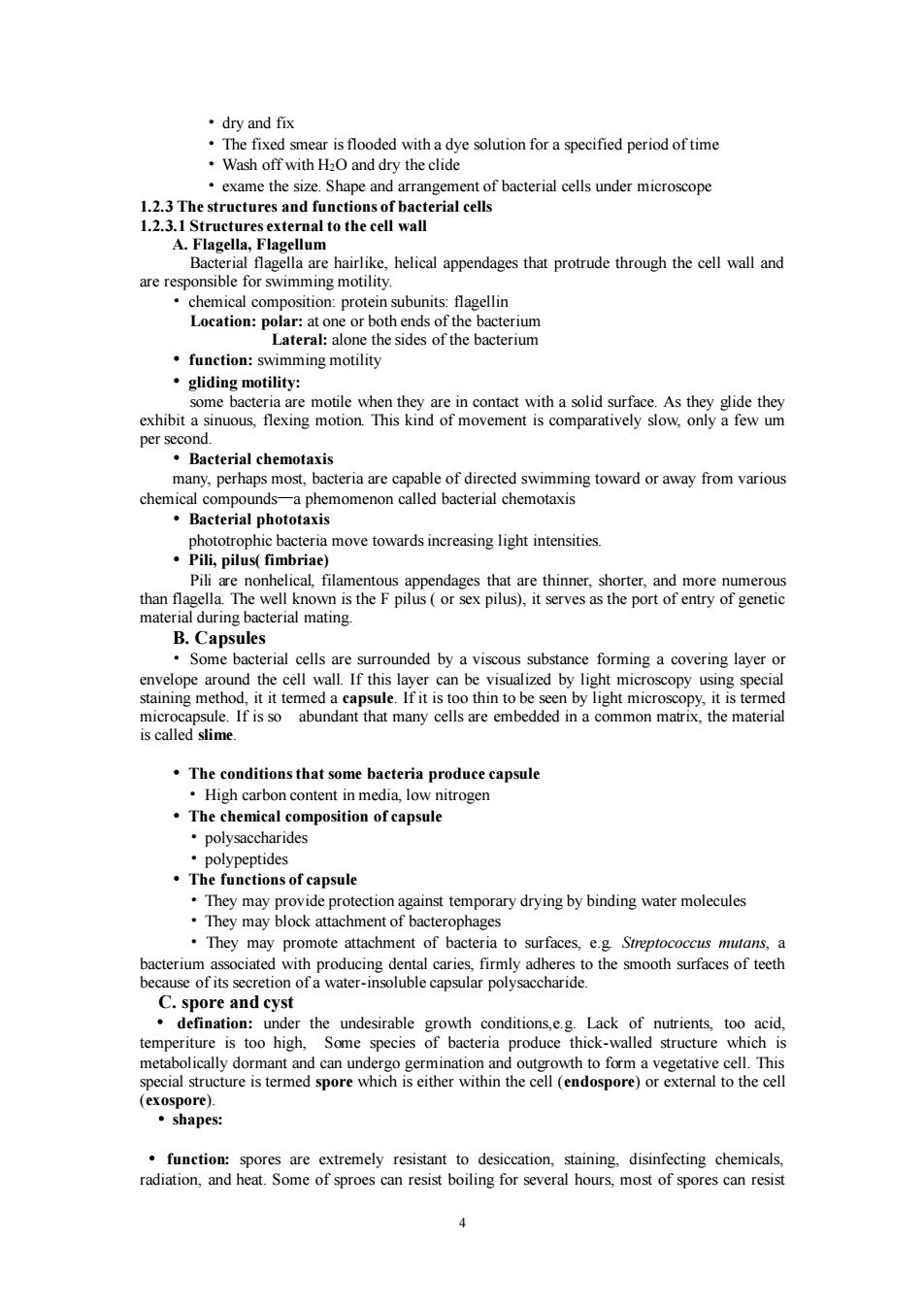正在加载图片...

4 • dry and fix • The fixed smear is flooded with a dye solution for a specified period of time • Wash off with H2O and dry the clide • exame the size. Shape and arrangement of bacterial cells under microscope 1.2.3 The structures and functions of bacterial cells 1.2.3.1 Structures external to the cell wall A. Flagella, Flagellum Bacterial flagella are hairlike, helical appendages that protrude through the cell wall and are responsible for swimming motility. • chemical composition: protein subunits: flagellin Location: polar: at one or both ends of the bacterium Lateral: alone the sides of the bacterium • function: swimming motility • gliding motility: some bacteria are motile when they are in contact with a solid surface. As they glide they exhibit a sinuous, flexing motion. This kind of movement is comparatively slow, only a few um per second. • Bacterial chemotaxis many, perhaps most, bacteria are capable of directed swimming toward or away from various chemical compounds—a phemomenon called bacterial chemotaxis • Bacterial phototaxis phototrophic bacteria move towards increasing light intensities. • Pili, pilus( fimbriae) Pili are nonhelical, filamentous appendages that are thinner, shorter, and more numerous than flagella. The well known is the F pilus ( or sex pilus), it serves as the port of entry of genetic material during bacterial mating. B. Capsules • Some bacterial cells are surrounded by a viscous substance forming a covering layer or envelope around the cell wall. If this layer can be visualized by light microscopy using special staining method, it it termed a capsule. If it is too thin to be seen by light microscopy, it is termed microcapsule. If is so abundant that many cells are embedded in a common matrix, the material is called slime. • The conditions that some bacteria produce capsule • High carbon content in media, low nitrogen • The chemical composition of capsule • polysaccharides • polypeptides • The functions of capsule • They may provide protection against temporary drying by binding water molecules • They may block attachment of bacterophages • They may promote attachment of bacteria to surfaces, e.g. Streptococcus mutans, a bacterium associated with producing dental caries, firmly adheres to the smooth surfaces of teeth because of its secretion of a water-insoluble capsular polysaccharide. C. spore and cyst • defination: under the undesirable growth conditions,e.g. Lack of nutrients, too acid, temperiture is too high, Some species of bacteria produce thick-walled structure which is metabolically dormant and can undergo germination and outgrowth to form a vegetative cell. This special structure is termed spore which is either within the cell (endospore) or external to the cell (exospore). • shapes: • function: spores are extremely resistant to desiccation, staining, disinfecting chemicals, radiation, and heat. Some of sproes can resist boiling for several hours, most of spores can resist4 • dry and fix • The fixed smear is flooded with a dye solution for a specified period of time • Wash off with H2O and dry the clide • exame the size. Shape and arrangement of bacterial cells under microscope 1.2.3 The structures and functions of bacterial cells 1.2.3.1 Structures external to the cell wall A. Flagella, Flagellum Bacterial flagella are hairlike, helical appendages that protrude through the cell wall and are responsible for swimming motility. • chemical composition: protein subunits: flagellin Location: polar: at one or both ends of the bacterium Lateral: alone the sides of the bacterium • function: swimming motility • gliding motility: some bacteria are motile when they are in contact with a solid surface. As they glide they exhibit a sinuous, flexing motion. This kind of movement is comparatively slow, only a few um per second. • Bacterial chemotaxis many, perhaps most, bacteria are capable of directed swimming toward or away from various chemical compounds—a phemomenon called bacterial chemotaxis • Bacterial phototaxis phototrophic bacteria move towards increasing light intensities. • Pili, pilus( fimbriae) Pili are nonhelical, filamentous appendages that are thinner, shorter, and more numerous than flagella. The well known is the F pilus ( or sex pilus), it serves as the port of entry of genetic material during bacterial mating. B. Capsules • Some bacterial cells are surrounded by a viscous substance forming a covering layer or envelope around the cell wall. If this layer can be visualized by light microscopy using special staining method, it it termed a capsule. If it is too thin to be seen by light microscopy, it is termed microcapsule. If is so abundant that many cells are embedded in a common matrix, the material is called slime. • The conditions that some bacteria produce capsule • High carbon content in media, low nitrogen • The chemical composition of capsule • polysaccharides • polypeptides • The functions of capsule • They may provide protection against temporary drying by binding water molecules • They may block attachment of bacterophages • They may promote attachment of bacteria to surfaces, e.g. Streptococcus mutans, a bacterium associated with producing dental caries, firmly adheres to the smooth surfaces of teeth because of its secretion of a water-insoluble capsular polysaccharide. C. spore and cyst • defination: under the undesirable growth conditions,e.g. Lack of nutrients, too acid, temperiture is too high, Some species of bacteria produce thick-walled structure which is metabolically dormant and can undergo germination and outgrowth to form a vegetative cell. This special structure is termed spore which is either within the cell (endospore) or external to the cell (exospore). • shapes: • function: spores are extremely resistant to desiccation, staining, disinfecting chemicals, radiation, and heat. Some of sproes can resist boiling for several hours, most of spores can resist